REport
Leadership in times of change: 5 key questions you need to know the answers to
Content
Welcome as a leader in 2024. The arrow is pointing upwards everywhere.
The demands for growth and results are increasing, the pace—and thus the demands for adaptability and willingness to change—are escalating. We are looking into a world that is only becoming more unpredictable—and a labor market that is increasingly demanding and mentally challenging
Intro
That’s the reality. So, why do you do it?
Well, it’s simple: Because it’s exciting, developing, competitive, and fun… especially for those who are capable of and willing to adapt their leadership approach.
The ability to lead through transformation is crucial
The playing field for leaders and organizations has shifted and continues to evolve, but the game remains captivating. There is constant development and change, and we can only speculate about what will happen in the field of AI, technology, and human dynamics in the future. As always, the most adaptable will win.
However, being the best is no longer defined by size, longevity in the market, or having the top products, methods, or brand. Instead, the best possess the power to transform and the ability to attract, nurture, and retain the brightest minds. It is the people who will drive your success.
That’s why your leaders must be better than ever. They need to be able to lead, motivate, and develop people—and they must be able to do so during times of change. They must foster enthusiasm for change, as not all employees love changes and strive for new goals as much as you do.
An important rule to remember: What is dopamine for C-levels can be cortisol for the organization. As a leader, you get the happiness hormones, while your employees may get stress hormones. Those are the hard facts—but leaders have the opportunity to change that.
Together, we grow the most
We have helped develop leaders and organizations for the past 25 years, and we have transformed countless organizations into something stronger. One thing remains constant: You will never succeed without a top management that is ambitious, persistent, and aware that people are the most important factor for success.
It’s actually quite simple. People in growth create organizations in growth, and leaders in growth create people in growth. That’s how the circle closes so neatly.
Therefore, we would like to share our experiences and initiatives on how to create transformation power and the ability to attract, develop, and retain the brightest minds. This is crucial for navigating the challenging balance between pursuing growth and managing an increasingly unpredictable world.
5 key questions you need to know the answer to:
|
Cohesion and Community
How do you establish cohesion and community?
01
Changes in today’s organizations should not be seen merely as projects. Instead, they should be seen as the way to survive and achieve better results. Therefore, transformation processes should not be seen as something to simply get through or as or as a drain on energy for both the organization and the individual.”
To navigate transformations effectively requires a new mindset where a shared identity and meaningfulness play a crucial role as driving forces. This is created by your shared purpose.
It’s about understanding why you are here, what you want to establish together, and what your mission and vision are. These elements set the standard for the decisions you make — but they also help make changes meaningful rather than something that just drains energy and drive.
A strong shared identity helps create a culture where change is a natural part of daily life and not just projects to be completed. This become essential when the world is constantly in motion. Therefore, changes are and will remain a permanent part of everyday life.
Does your shared identity have what it takes?
In times like these, with constant change, it’s important for any organization to ensure that there is a strong foundation for the shared identity. You need a strong shared identity to build the community and set the direction necessary in order to establish a ‘sense of urgency’ around your goals.
When organizations succeed in establishing a culture where changes are considered as part of everyday life and not as threats, and where the shared identity guides behavior and decisions, organizations not only survive — they thrive.
Because with a stable foundation, people are much more capable of thriving in turbulent times. For organizations, this means having the basics in place — who you are and what you believe in.
Faster Growth:
Companies with a strong purpose double their market value 4X faster
Improved Performance:
A 10% improvement in employees' connection to the organization’s mission or purpose results in 12.7% fewer safety incidents, 8.1% lower employee turnover, and 4.4% higher profitability
Direction over control and management
A strong shared identity arises when people feel they are united in something meaningful. In organizations, this meaning is typically formed through vision, mission, and values—what we call the strategic guidelines.
These strategic guidelines set the direction and help shape the framework for the organization’s behavior and decisions. They give purpose to why you are here, where you are going, and how you will get there.
As long as the top management agrees on the overall direction, they can let go of control and give the organization the freedom to interpret and develop how to reach that goal. With a light structure in place, the freedom to act and make decisions can generate a great energy and drive within the organization—and it’s worth it.
Especially in a complex world, it is necessary to understand that more management and control merely foster more complexity, rather than increasing trust and engagement—at least when the framework is in place.

What are the strategic guidelines?
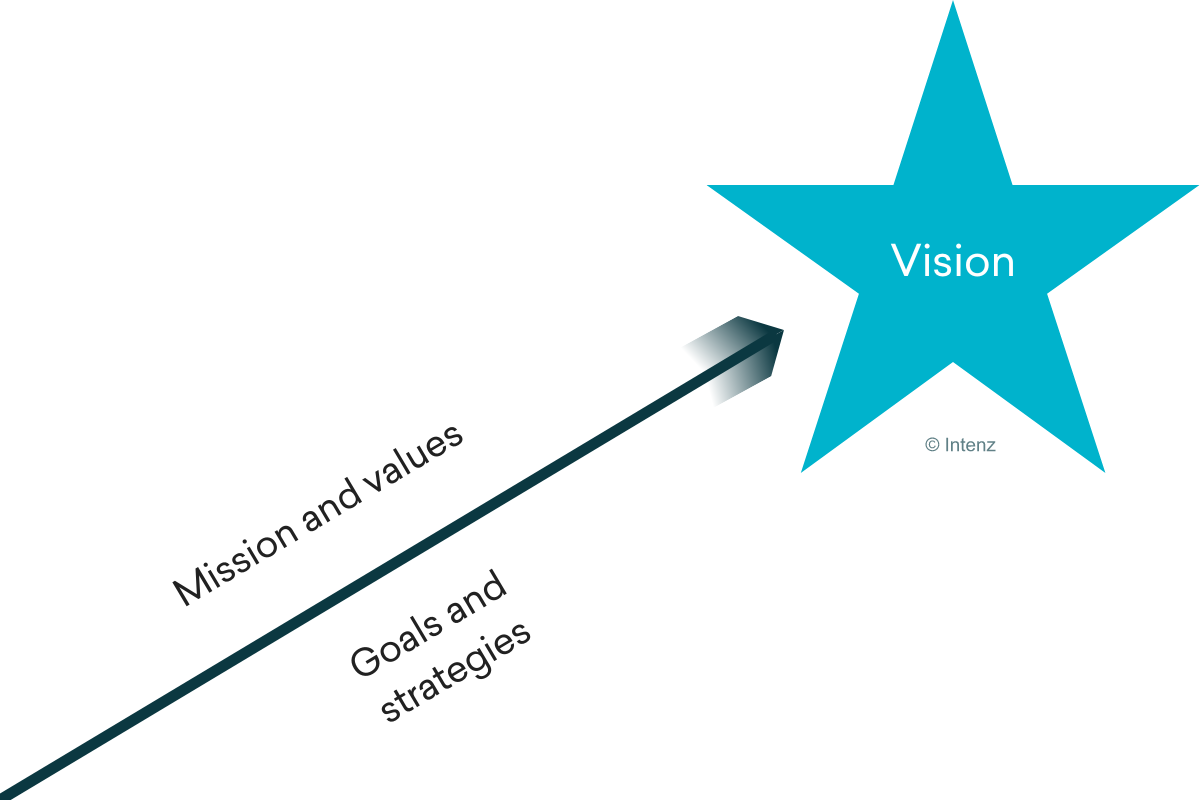
Strategic Goals
The strategic goals are the overall objectives that guide you toward your long-term vision. It’s about identifying the key areas where you need to focus your effort to achieve growth and results.Mission
The mission is often referred to as the organization’s DNA, purpose, or WHY. Regardless of the name, the mission explains why you exist as an organization and what the foundation of your existence is.Vision
The vision is also often called the dream goal, ambition, or objective. The vision is your lighthouse and guiding star, drawing you in the right direction like a magnet.Values
The values describe how you want to be together on the journey and what should characterize your behavior, communication, and collaboration. The values should indicate the type of behavior you wish to encourage.
Do you have the foundation for your shared identity in place?
Most organizations have defined their strategic guidelines to some extent. The meaning has been articulated and discussed. However, several of the organizations we have assisted in the past have struggled to form a strong enough commitment to the strategic guidelines within the organization.
The strategic guidelines are understood, but they don’t live in the heart, and employees find it challenging to translate them into actual behavior and decisions.
This is where the difficulty lies—but also where the value is.
When you use your guidelines in daily operations as a compass—not just for your identity, but for your behavior and decisions—you form the culture that determines whether you succeed in achieving your goals.
A good exercise: Testing the guidelines you follow
It is often difficult to translate strategic guidelines into practice when you haven’t done enough to define and discuss behavior. However, it could simply be because what you have described is not strong enough to withstand the challenges that employees and organizations face.
That’s why it’s a good idea to test your strategic guidelines.
- Examine the facts: Have you defined strategic guidelines that make sense, foster unity, and set the direction for behavior and decisions across the organization?
If not, that’s a good place to start.
- If yes, check the quality: Does the world still look the same as when you formulated your strategic guidelines? Are your strategic guidelines strong enough to meet today’s reality?
If you know the answer is ‘yes’, it’s about bringing the strategic guidelines to life within the organization. If you think the answer is ‘yes’, you need to investigate further. If the answer is ‘no’, it’s time to revise your strategic guidelines.
Your leadership philosophy is (also) an important guideline
What type of leadership do you believe in, and how do you overall describe it?
No vision, mission, or values can thrive without good leadership. Therefore, you need a leadership philosophy that defines what good leadership looks like in your organization. What do we believe in, and how do we practice good leadership?
The leadership philosophy is thus a guideline that supports overarching ambitions. However, it doesn’t describe in detail the “HOW TO.”
Across organizations, leaders may practice leadership in different ways. Some lead in an inclusive and engaging manner, showing great trust in their employees. Others take a more controlling and directive approach, showing less trust in their staff. These can be seen as two opposing poles.
But it’s crucial to have a shared leadership philosophy that creates calm, security, consistency, and the foundation for knowledge sharing.
The situation your organization is facing plays a big role in choosing which leadership philosophy that will have the most impact on your overall leadership. For example, in periods of uncertainty or major change, there may be a greater need to focus on stability rather than innovation. This calls for two very different leadership philosophies.
What is right or wrong is difficult to say. It’s about defining the leadership philosophy that is right for your organization, ensuring clarity, and making sure it’s consistently applied.
What does a leadership philosophy include?
What does a leadership philosophy include?
What is our believe about people? To what extent do we believe that employees have an inner drive where they are self-motivated, creative, hardworking, helpful, proactive, and eager to make a difference in collaboration with others? Are we at one extreme, where we are confident that the employees can find all this huge motivation on their own and master self-leadership… or are we at the other extreme, where we believe that people are driven externally, that no one acts on their own without instruction, reward, or punishment?
What describes what you believe in and aspire to in your company?
What do we believe is good leadership?
Once you have defined what you believe about people, you need to define which leadership style you think fits that belief. On one side, there is a need for a leadership style with a high degree of involvement and autonomy, with few individual goals, KPIs, and processes. On the other side, we find a high degree of management and control with strict processes, KPIs, follow-ups, and instructions. You will typically fall somewhere in between, but likely lean strongly towards one of the sides.
One of the most important questions is: Do you believe that people are internally driven or externally driven?
- Internally driven: When you believe that people are internally driven, you typically focus on setting purposes and involving people in goals and action plans.
- Externally driven: When you believe that people are externally driven, you typically work with concrete objectives that trigger bonuses.
The big difference lies in the fact, when you believe in internal drive, it’s about inclusion and involvement because it creates ownership, whereas external drive is more about the “carrot and stick” approach.
So, what do you believe? A leadership philosophy is about defining the specific leadership approach that is right for your organization, so you can in the best possible way can move towards your common goals.
Priorities for creating cohesion and community
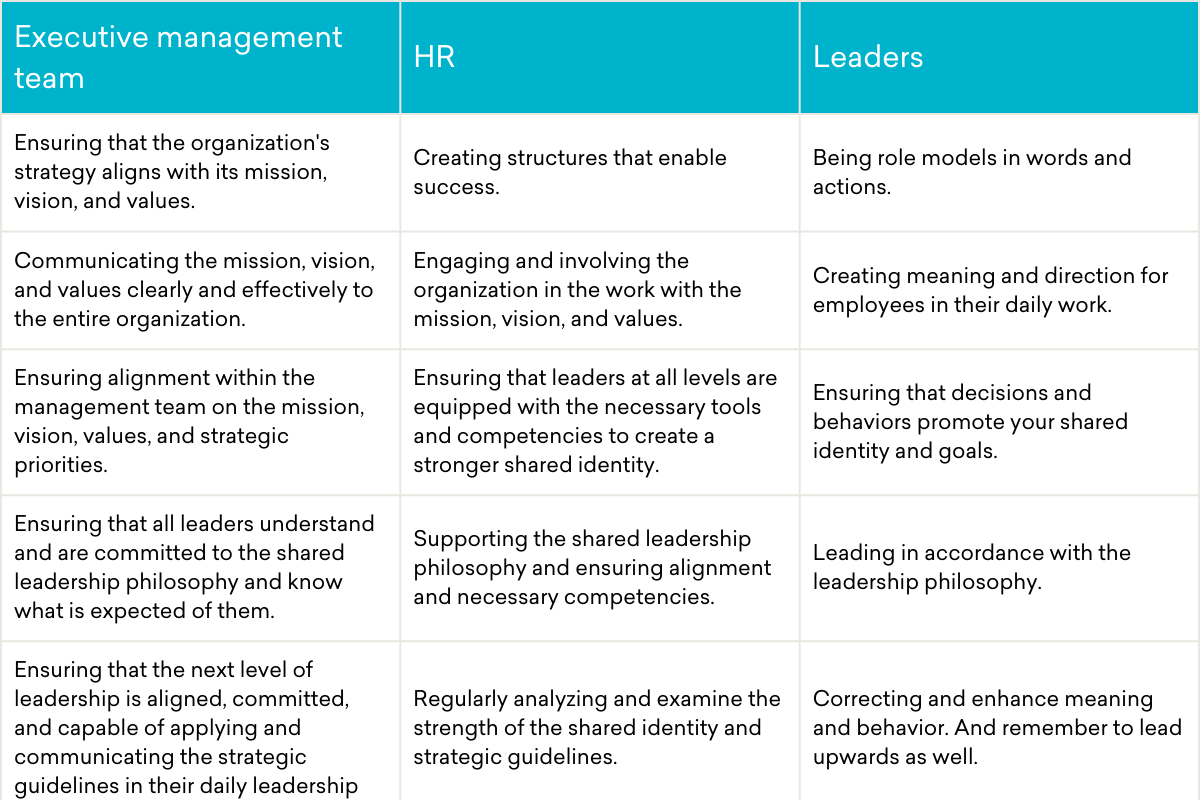
Strategic priorities
How do the strategic priorities ensure your choices and deselections?
02
Often, the path to better results is focused on pushing the accelerator harder — meaning doing more of the same or demanding more. Instead, organizations should find an extra gear by consciously working with their strategic priorities.
Your ability to make the right choices and deselections determines whether you succeed or fail with your strategy. Are you capable of prioritizing correctly?
It’s about real prioritization — and those priorities must foster a drive for the entire organization, not just for those who designed them.
Here are a few facts that show why strategic priorities are often a challenge:
- Out of 2.207 leaders, only 28% felt that the quality of strategic decisions was generally good (McKinsey — The Case for Behavioral Strategy).
- Only 15% of employees actually know their organization’s most important goals — either there are no goals, or there are too many (Franklin Covey).
- 91% of all projects are either “over-time, over-budget, or under-benefit” (Bent Flyvbjerg).
- Teams that focus on 1–2 goals achieve all of them.
- Teams that focus on 4–10 goals only achieve 1–2.
- Teams that focus on over 10 goals achieve none (Sean Covey).
Are priorities about personal or collective needs?
The process of selecting the most important goals and priorities can challenge many strategies. In fact, deciding on shared strategic priorities together is one of the best team exercises for a leadership group.
Typically, the process starts with the leadership team having a shared understanding of what’s at stake. There is agreement on what you need to succeed with in the upcoming period to become more relevant to customers, employees, and partners.
It may sound easy, but it requires dialogue and putting aside personal goals and needs. It’s about maintaining a continuous focus on the whole, something most are not accustomed to in everyday work.
And how do you do that? We call it a CEO mindset.
This means that, as a group, you are able to view the situation as a whole. It is crucial to identify tunnel vision, silo thinking, and limiting beliefs so that you can find the priorities that will form the foundation for future decision-making regarding the team and the organization.
When you succeed in this, you simultaneously create a more cohesive leadership team, which provides the sense of security that is essential for the rest of the organization during transformation processes.
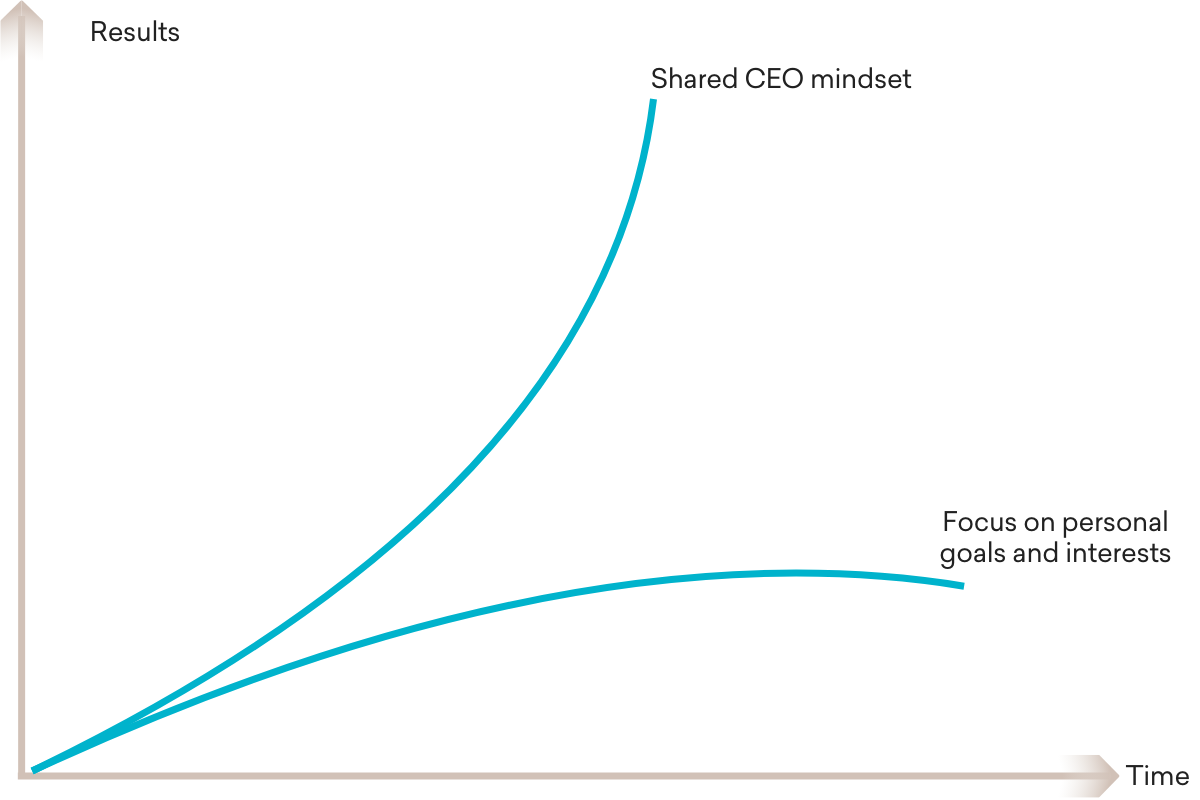
4 signs that it’s time to work on priorities
- Lack of clear common goals
- Internal collaboration is struggling
- Lack of cohesion between top management, middle management, and the rest of the organization
- A feeling of inadequacy, even though everyone feels they are working hard
Get the process under control: Start with what you want to create together and make it concrete
Most people genuinely want to perform well — and when they feel they’re not measuring up, it creates a sense of inadequacy or even stress.
It goes without saying that you can’t achieve everything in the world at the same time. This is something you need to be aware of as well. That’s why it’s crucial to make clear to everyone what you want to achieve as an organization — and when to choose X over Y in a busy workday. This applies especially when you want changes.
Your leaders need to be equipped to lead individuals and teams in a way where you find energy and drive in the things you’ve chosen to prioritize. Most of all, because you feel you’re making a difference together.
But leaders can only do this if you succeed in translating the strategic priorities into more tangible and concrete goals.
Here lies one of the challenges: Many organizations overlook or underestimate one or more key points in the translation process from strategy to something executable and tangible.
In fact, up to 80% of leaders consider their organization’s strategic methods to be “ineffective” (McKinsey — Return on Strategy).
The cornerstones of clear strategic priorities
There are many ways to approach the process of moving from overall strategy to making it more tangible for the rest of the organization.
Here are some of the most important things we always recommend to our clients when it comes to refining everything from strategic goals to concrete behavioral goals — Key Behavior Indicators (KBI’s).
01
Shared Identity and Direction
Are we aligned on what we stand for and strive for together?
02
Strategic Goals
Which 2-3 strategic objectives must we achieve within a given period?
03
Strategic Priorities
Descriptions of the choices and deselections related to the 2-3 strategic objectives we have.
04
Strategic Activities
Which activities should we specifically start or stop to increase our chances of success with our priorities?
05
Actions and Goals
What should we look for to confirm that we are doing the right things in the right way? Do we have clearly defined KPIs and KBIs?
Involve the organization in the priorities — and get everyone on board
To successfully involve the organization in the strategic priorities in a way that really gets under the skin, it first and foremost requires a heartfelt commitment. That’s why the feeling of cohesion and community is absolutely crucial.
But how do you achieve that?
The shared identity and direction create the framework for why you want to achieve your strategic goals. This is where the meaning lies – your fuel for the journey.
The strategic priorities are the playing field, but they only gain value when leaders can communicate them in a way that allows employees to see themselves in them.
Leaders must be able to communicate the strategic priorities and explain what is at stake so that employees can see how they can contribute and become engaged. It needs to be so concrete that each individual employee can explain their contribution, help make ongoing choices, execute on those choices, and evaluate the results.
The heart must be involved.
The alternative? Without clear strategic priorities, you risk working in different directions. This leads to inefficiency and misunderstandings, making it difficult to translate overarching strategic goals into concrete actions and daily tasks – something that is essential for creating momentum for the necessary changes.
But what skills are required to communicate the strategic priorities, involve, and create driving force?
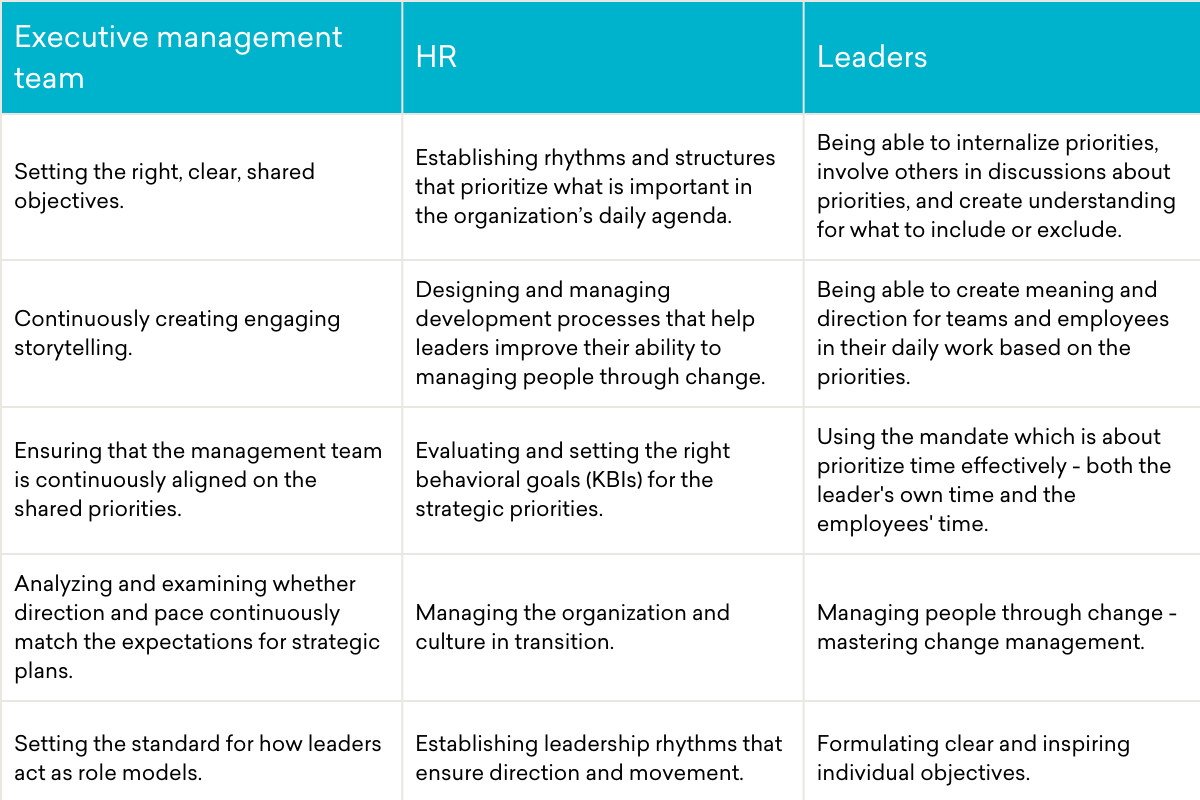
Make better decisions
How can the management team make better decisions together?
03
A high-performing management team has a greater impact on the entire organization’s ability to deliver results than most realize. The team sets the direction and pace for the whole organization.
But how do you ensure that the leadership group develops and builds a strong sense of unity, so you can increase value creation — benefiting the entire organization?
There are several crucial areas that need to be in place to create a strong management team that can serve as role models for midlevel leaders and the rest of the organization:
- The management team must believe in the same things, be passionate about the same things, and share common values.
- The management team must agree on what they stand for and the direction they want to drive the organization in (the shared goals).
- The management team must have clear agreements on roles and responsibilities — and they must master the competencies that come with those roles and responsibilities.
- And last but not least, there must be strong relations and trust within the management team.
What does it look like when it doesn't work?
There are many symptoms indicating that the top management team is not aligned on attitudes and goals… because it has significant consequences for both efficiency and results when alignment is missing.
The most important symptoms are:
- Lack of clarity and direction
Without a shared understanding and agreement on goals and values, the organization may experience uncertainty about direction. This can lead to confusion about expectations and priorities among middle managers and employees — and in the worst case, a silo culture. - Ineffective communication
When the top management is not aligned, conflicting messages can arise, leading to confusion and misunderstandings throughout the organization. Effective communication is essential for implementing strategies and goals, and without a united front, the messages can lose their power and significance. - Low morale and motivation
A lack of alignment can create a sense of uncertainty and insecurity among employees. When employees don’t see a clear and cohesive direction from the management, their motivation and trust in the organization may decrease, negatively affecting productivity. - Failure to execute strategies
One of the most direct consequences is that strategies and projects are not executed effectively. Disagreements within top management can trickle down through the organization, resulting in poor collaboration due to conflicts. In the end, strategic initiatives are delayed or fail. - Waste of time and resources
Disagreements can lead to many internal conflicts and delays, wasting time and resources that are either not used correctly or are simply wasted. The organization may end up spending time dealing with internal issues instead of focusing on external challenges and opportunities. - Weak decision-making
When top management is not in agreement, the decision-making process can become slower and less effective. This can result in missed opportunities and an inability to respond quickly to market changes.
Overall, it is crucial for the success of the organization that the top management works together towards shared goals and values. This creates a strong and clear direction, effective communication, high engagement, and a strong execution of strategies.

What should you create together — and what should you stand for?
To make better decisions together, it is essential to ensure that the entire management team is on the same page about the fundamentals — namely the shared identity or DNA that shapes the organization and its cohesion.
This can be your mission, vision, and values — or whatever you call it in your organization. Fundamentally, it’s about what can be referred to as the core. These elements provide a stable foundation for each individual, even when things change rapidly.
Bringing the mission, vision, and values to life within the organization starts at the top leadership level. Therefore, it is crucial that the top leadership believes in and communicates the same message, so the organization does not experience mixed signals or unclear communication. This is where your leadership philosophy plays a central role.
Your management team must be 100% aligned on the leadership philosophy and goals
A leadership philosophy is about defining the specific leadership approach that fits your organization. The one that will best guide you toward your shared goals.
This means that the management team must be 100% aligned on what type of leadership they will practice. In organizations where this is unclear, the uncertainty trickles down through the organization, creating confusion and insecurity.
Middle managers lack clear role models because they experience different types of leadership depending on which senior leader they look to. Similarly, employees experience confusion about what constitutes good behavior, as it varies depending on which leader they interact with. While one department may have a very inclusive leadership style with individual freedom, another may have a highly controlling and structured style.
This makes it difficult for both employees and middle managers to navigate and creates not only the foundation for an unhealthy silo culture but also hinders strong cross-departmental collaboration, which is crucial for success in today’s organizations.
Ways of working together
Although alignment on the leadership philosophy is important, it cannot stand alone. An effective management team requires clear and agreed ways of working together with structured work processes and clear lines of communication.
Transparency and openness in the communication are key elements in ensuring that all team members feel heard and involved. Regular meetings to discuss progress, challenges, and decisions are essential for maintaining a coordinated effort and avoiding misunderstandings.
Another aspect is the need for a clear distribution of responsibilities and roles so everyone knows what is expected of them and how they can best contribute to the team’s success.
Here, clear agreements on collaboration can be beneficial in the form of a ‘Ways of Working agreement’ — a description of how you do things together.
Development of competencies in the management team
Continuous competency development is essential to ensure that the management team can make informed and effective decisions. This involves both individual and collective development. Team members should be trained in relevant skills such as strategic thinking, change management, communication, and self-management.
Development requires an investment of time and energy, but it also ensures that the leadership team stays up to date with the latest tools and methods necessary to lead others in a busy environment. Training and development should not only focus on technical skills but also on enhancing the team’s ability to collaborate and make better decisions together.
Team cohesion and psychological safety — relations and trust
A strong sense of team cohesion is the foundation for effective decision-making. This means that team members trust each other and feel safe sharing their opinions and ideas. Psychological safety in the team can be achieved through open dialogue, mutual respect, and support.
It is also important to create a work environment where there is room for mistakes and learning, so team members feel encouraged to take initiatives and experiment with new solutions. By focusing on team cohesion and psychological safety, the management team can build a stronger sense of unity, making the employees better equipped to handle difficult decisions.

Priorities to ensure that the management team makes better decisions together
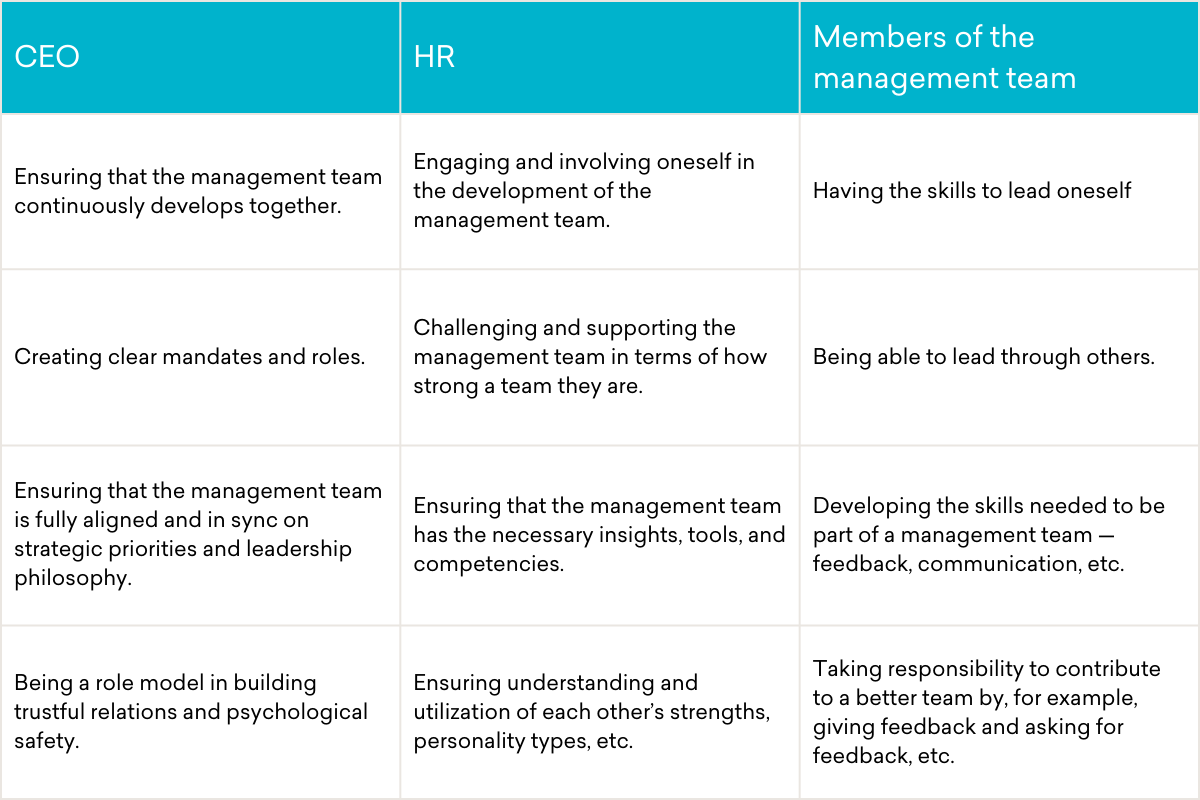
Create optimal conditions
How do you create optimal conditions and support for your leaders?
04
No matter how skilled your leaders are, poor conditions can make it difficult to practice effective leadership — and achieving results through others can become a challenge.
Leadership is increasingly becoming a team sport, as collaboration must be seen as key to achieving your goals. This creates a whole new set of demands on how to manage and develop leadership.
- 83% of organizations believe that developing leaders at all levels is important, but only 5% do it effectively (Source: Harvard Business School).
- Organizations that have an Operating Model are 2.3 times more likely to be among the top high-performance organizations (Source: McKinsey & Company).
- Only 48% of leaders strongly agree that they have the necessary skills to be excellent in their work (Source: Gallup).
This is why it’s more necessary than ever to create better coherence between strategy, structure, processes, and culture in order to succeed.
One way to make it more concrete is by creating better coherence between the goals you strive for and the leadership behaviors you seek. This can be achieved by working with the three key concepts below..
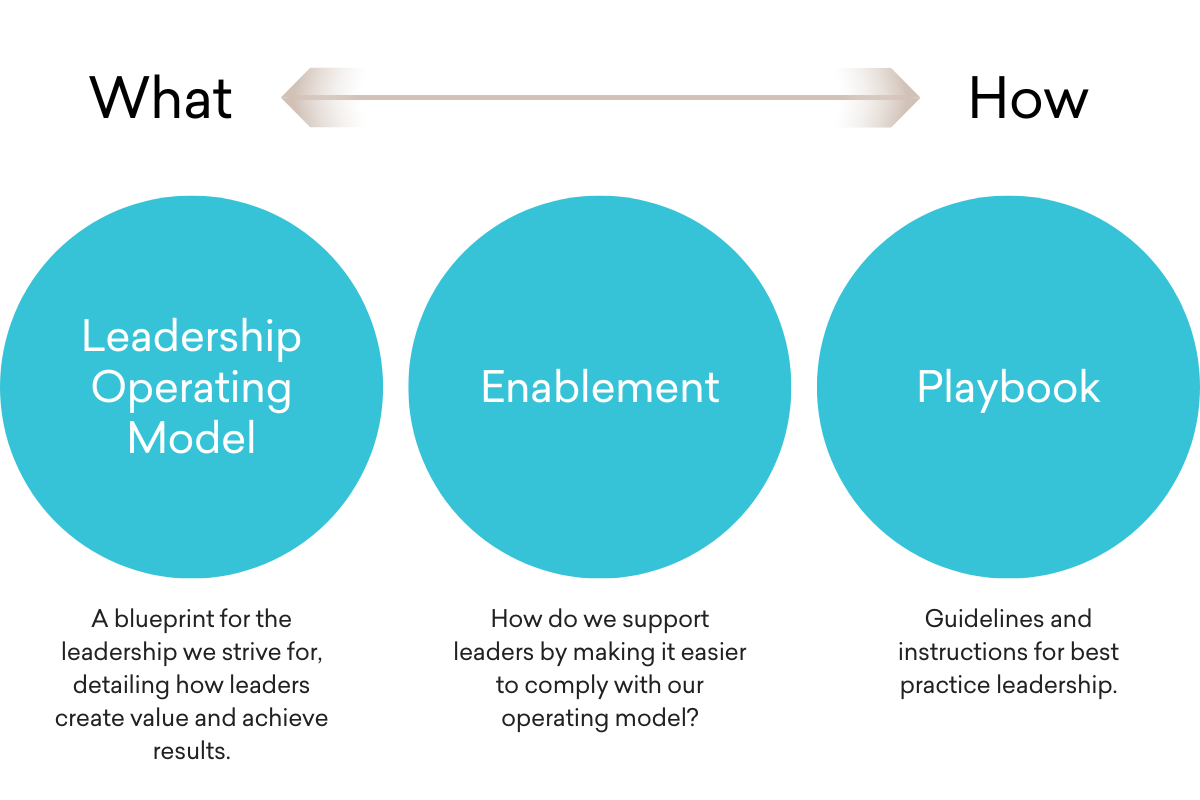
A Leadership Operating Model is a must-have
In our opinion, a Leadership Operating Model is essential for any organization. But what exactly is it?
In short terms, a Leadership Operating Model provides a description of your shared approach to leadership and your ways of working within leadership. It’s a blueprint that outlines how you manage leadership and culture and creating the right prerequisites.
A Leadership Operating Model sets the standard and ensures that your best practice is easy to follow, no matter how complex your organization is. It includes how great leadership is understood and implemented, how you collaborate, how you are onboarding new employees, and how IT systems are used to maximize their benefits.
A Leadership Operating Model is absolutely essential for shifting from simply doing more to actively fostering the leadership behaviors you want to see more of.
Make it easier to lead well with Leadership Enablement
Leaders today have a lot on their plate. Their days are filled with decisions, meetings, inputs, and distractions. The easier you can make it to be a leader in your organization, the better leadership you’ll get because it’s easier to stay focused.
Leadership struggles in many organizations — for various reasons. Anything from challenges in dedicating time to leadership, to lack of access to the right resources, poor collaboration, and ineffective leadership training and development.
When an organization wants to improve leadership, we often see that the first step is to go straight to developing the skills of the leaders. However, research shows that it’s more effective to first analyze and understand a handful of crucial areas to ensure the right choices are made — but also to enable the kind of leadership needed for the leaders to truly become the driving force in change processes.
The purpose of Leadership Enablement is to create an organization where leaders can do what they are meant to do — lead. How? By removing obstacles and ensuring they have the right resources.
The organizations that succeed in improving leadership and achieve greater success with transformations work in a structured and conscious manner with a handful of key areas. You can see these in the model below.
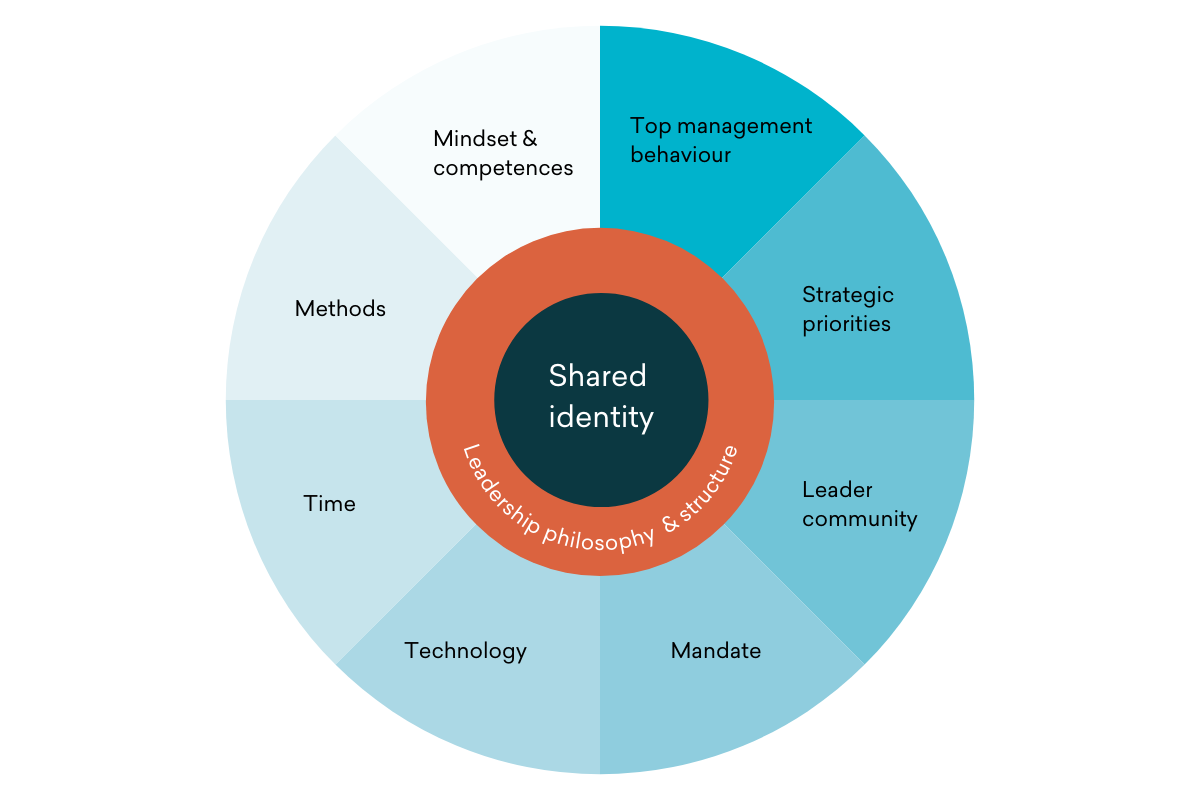
Priorities for creating optimal frameworks and conditions for the leaders
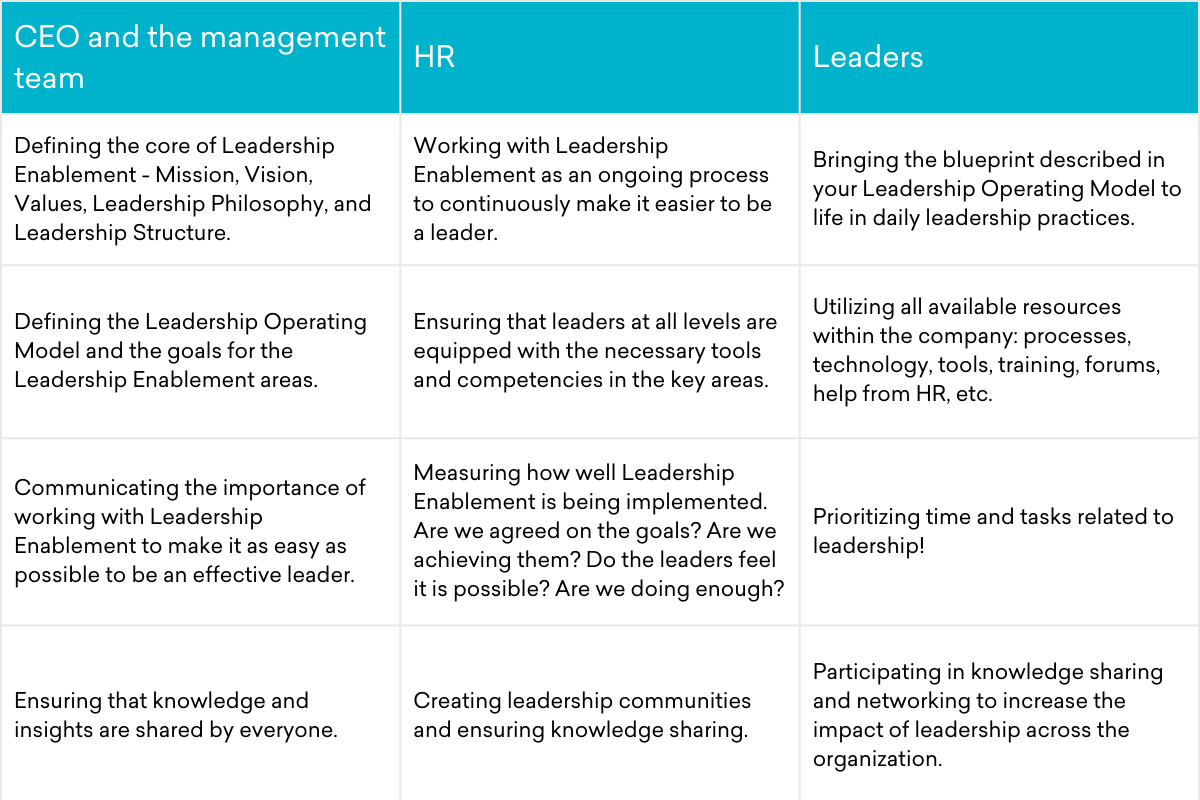
Resources & Competencies
Do your leaders have the necessary resources and competencies?
05
Basic leadership skills are a must for any leader — but there’s now an additional layer, as leadership is just as much about leading groups as it is about leading individuals.
Therefore, it’s necessary to develop leaders’ competencies to strengthen their ability to lead strong communities. However, changing habits and acquiring new skills as a leader can be difficult, uncomfortable, and unfamiliar.
This makes it absolutely crucial that you approach the task of developing leadership competencies with respect for the fact that it requires more than just a 2-hour workshop.
Here are the 5 steps we use when helping our clients:
- Analyze the starting point – your A. Where are you in relation to the desired behavior goals?
- Define clear goals for development – your B. Both result goals and, more importantly, behavior goals.
- Plan the development to move from A to B. From design to development to behavior change.
- Design and describe tools, methods, processes, and behaviors you want to master.
- Plan how the development will be anchored in everyday life – before, during, and after the development process.
Leadership development should help leaders solve their tasks better
Development processes should not be just another task to check off. Instead, development should help leaders perform their leadership tasks more effectively.
Initiatives such as workshops, individual coaching, on-the-job training, and peer groups can be both ineffective and effective. It depends on whether the content is designed to develop leadership competencies in themselves or to solve business challenges.
Ultimately, a combination of initiatives has the most significant effect. This shows the trend, at least. A single initiative rarely stands alone when creating development that lasts in the long run.
Three levels a skilled leader must master
The question is, what must a skilled leader be able to do? What competencies are needed?
First and foremost, it’s about leading on multiple levels. Here are three levels that leaders must navigate and lead effectively on. Each level, of course, requires different skills.
- Leading oneself:
Leaders must be able to look inward and lead themselves
Questions:
What drives me?
Why do I react the way I do?
How do I become the best version of myself when leading others? - Leading people close to you:
Leaders must be able to lead the people in their team.Questions:
Who am I leading?
What does the context look like?
What different needs exist?
How should I adjust my leadership? - Leading an organization:
Leaders must be able to lead communities, where it’s about units and not individuals.Questions:
Which units should I lead?
How should the units work together?
In short, a skilled leader must be able to drive both the business, and the people based on a shared core.
At all levels, the leader’s most important tool is themselves. The leader’s knowledge, experience, authenticity — and the ability to bring it into action. Whether it involves different needs, drives, expectations, motivation, conditions, or disciplines.
Challenge-Based Learning over traditional leadership development
Challenge-Based Learning over traditional leadership development
When do you sign up for a beginner’s Italian course?
… when you’ve booked a holiday to Italy.
The same goes for leadership development. To get the most significant impact from leadership development, it’s about developing leaders while they solve real challenges. A concrete example could be a leadership program where the participants in advance define a specific challenge they face in their organization. For instance, a leader might aim to improve the communication and collaboration in their team.
Here are the differences between Challenge-Based Learning and classical leadership development:
- Relevance and Applicability:
- Challenge-Based Learning: Leaders work on real challenges they face in their daily work, making the learning immediately relevant and applicable.
- Classical Leadership Development: Learning often happens through theory without a direct connection to the leaders’ current challenges, which can result in a lack of relevance and lower motivation to apply the new knowledge in practices
- Transferability:
- Challenge-Based Learning: By working with concrete challenges, you ensure that leaders have an incentive to transfer new skills directly to their daily leadership. Emphasis is placed on implementing new habits and processes.
- Classical Leadership Development: There may be a lack of follow-up, meaning the learned skills are not necessarily applied in daily life. Leaders return to their work without a clear plan for how to implement the new knowledge.
- Engagement and Motivation:
- Challenge-Based Learning: Learning is more engaging because the participants work on something directly relevant to their success and engagement. The challenges are personally relevant, which increase motivation.
- Classical Leadership Development: Leaders may find it challenging to relate to the theories and topics, especially if they don’t see a direct connection to their own work.
Challenge-Based Learning promotes a deeper understanding and ensures that new skills and knowledge are applied in everyday life. This often results in better outcomes and higher engagement compared to traditional teaching.
After all, what’s it really about? It’s about embedding new skills and knowledge as habits that stick.
Cases
Get more inspiration for developing your organization in cases from collaborations with our clients below. Feel free to contact us if you have any questions.





